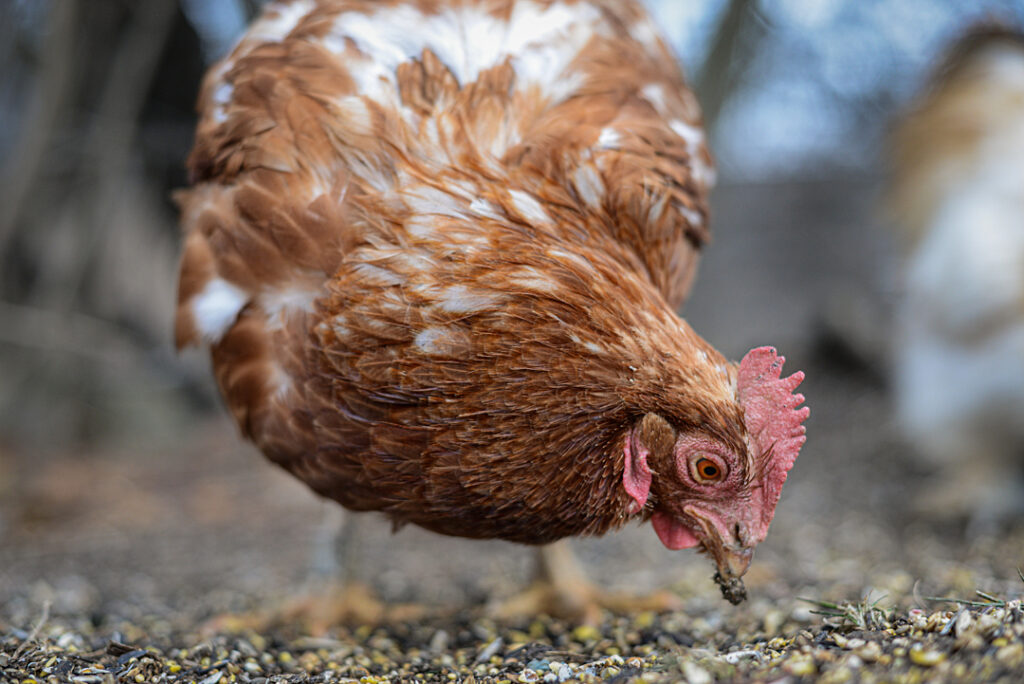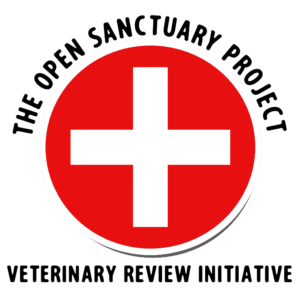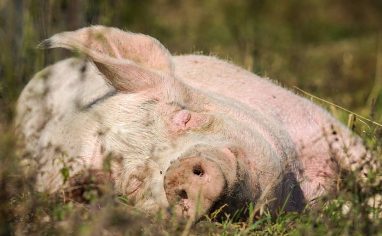

Veterinary Review Initiative
This resource has been reviewed for accuracy and clarity by a qualified Doctor of Veterinary Medicine with farmed animal sanctuaryAn animal sanctuary that primarily cares for rescued animals that were farmed by humans. experience as of January 2025.
Check out more information on our Veterinary Review Initiative here!
Heavy metal toxicosis is one of the most common causes of toxicity in birds. While there are a number of heavy metals that can cause toxicity, lead and zinc are the most common causes and will be the focus of this resource. Heavy metal toxicity can cause serious health issues and can be fatal, so prevention is key!
This Resource Is Focused On Farmed Bird Species
Heavy metals are a common cause of toxicity in parrots, but please note that they are not our focus in this resource. While the sources of lead and zinc included in this resource would also be a risk for parrots, parrots face additional risks and can exhibit additional and/or different symptoms not described below.
Exposure To Heavy Metals
Birds are most often exposed to heavy metals by ingesting substances that contain lead or zinc. While both lead and zinc can result in toxicity, there are some key differences between the two metals. Zinc is an essential trace mineral that is found in low levels in the body. Zinc has a safe range – too little can result in deficiency and too much can result in toxicity. Zinc toxicity is usually the result of chronic and/or repeated exposure to zinc. Lead, on the other hand, has no biological function and has no safe range. There are numerous ways bird residents may be exposed to lead or dangerous levels of zinc. Below we’ll highlight potential sources of exposure that are particularly important for caregivers of farmed bird residents to be aware of.
Additional Risks
Please note that while ingestion of substances containing lead or zinc is the most common way birds are exposed to heavy metals, they can also be exposed via inhalation (such as from inhaling fumes from welding or smelting) and can also develop toxicity as a result of exposure to other heavy metals such as mercury or cadmium.
Contaminated Soil
Soils naturally contain low levels of lead, generally 15-40 ppm (15-40 parts lead per million parts soil). However, due to hundreds of years of human pollution, in some areas lead levels in soil can be several thousand ppm. Because it does not break down in the soil, lead from previous products and practices that are no longer common today continues to pose a risk. Lead-contaminated soil is of particular concern in urban areas, around older homes, and near roadways, industrial sites, and toxic waste sites.
Similarly, human activities such as mining, smelting, steel production, burning coal, and improperly disposing of zinc-containing waste from metal manufacturing can release zinc into the environment, leading to soil contamination. Fertilizers can also lead to increased zinc levels in soil.
Birds scratching and foraging in soil contaminated with lead or zinc are at risk of developing toxicity. You can have your soil tested to determine if lead or elevated levels of zinc are a concern. We recommend consulting with your veterinarian or the testing lab for guidance, especially regarding sample collection. Heavy metals may not be distributed evenly through the soil, so collecting multiple samples and considering where contamination is most likely and where your bird residents are most likely to spend time is often recommended. For example, with lead, the area surrounding an older home would be a prime spot for contamination from lead paint chips. If the space your bird residents have access to includes an area bordering an older home, this would be an area you would want to collect a sample from.
If your soil is deemed unsafe, you will either need to restrict your residents’ access to it by moving them to a different space, or you will need to take other steps to prevent contact. Dr. Marieke Rosenbaum of Tufts University Cummings School Of Veterinary Medicine recommends covering contaminated soil with at least two feet of clean soil and then retesting the soil each year.
Contaminated Water
Just as soil can be contaminated with lead or zinc, so too can water. Lead pipes, fittings, faucets, fixtures, and welding solder can contaminate water as they corrode. Brass plumbing materials may also contain some lead which could result in contamination. Even “lead-free” pipes and plumbing materials may contain low levels of lead. Garden hoses are often used to provide water in outdoor living spaces, and these as well as their fittings can also be a source of lead contamination.
Drinking water usually contains some zinc, but zinc levels can become dangerously elevated due to the same activities and substances described above that contribute to elevated zinc in soil. Plumbing coated in zinc can also result in elevated levels of zinc in water, as can storing water in metal containers.
Galvanized Water Dishes
While some sources suggest that, so long as they are in good condition and not used in conjunction with acidic additives such as apple cider vinegar, the use of galvanized metal dishes poses little risk to birds, others adamantly state that galvanized dishes should never be used because of the risk of zinc leaching into the water. We at The Open Sanctuary Project always err on the side of caution when it comes to resident safety and, therefore, we suggest looking into other options besides galvanized metal for food and water dishes. Given the impacts of heavy metal toxicity, we simply feel it’s not worth the risk when there are other options available. Please note as well that even if dishes are labeled “stainless steel” or “lead and zinc free,” it is still worthwhile testing them should you suspect or encounter heavy metal poisoning in your residents.
To ensure the water you provide to your residents is safe, you should have your water tested at each point of use. As a side note, ensuring your water is safe for residents goes beyond checking for heavy metals. You can read more about this topic here. If testing reveals that your water is unsafe, you will need to switch to a safe water source (such as purchasing safe drinking water).
Choosing Safe Hoses
If you use hoses to provide water, you must also consider the risk of the hose and/or fittings leaching lead or other harmful materials into the water. Results from a 2016 garden hose study released by The Ecology Center (which was focused on human safety, not avian safety) showed that hoses labeled “Drinking Water Safe” tend to contain less harmful substances (including lead) than other hoses. They recommend avoiding PVC hoses, which are more likely to contain heavy metals, flame retardants, and phthalates. You can read other consumer recommendations they made based on this study here. Regardless of the hose you use, they recommend letting the water run for approximately five seconds before using it and storing hoses in the shade because heat increases the risk of plastic additives leaching into water.
Ingestion Of Foreign Bodies
Foreign body ingestion (which you can read more about here) poses several risks to individuals, including gastrointestinal obstruction and damage to the gastrointestinal tract. For birds, in particular, an additional concern is the risk of heavy metal toxicity if the foreign body contains lead or zinc. Examples of items that may result in heavy metal toxicity if ingested include but are not limited to the following:
- Carpentry hardware such as screws, nuts, and bolts
- Galvanized materials (hardware cloth, wire, mesh, nails, metal)
- Paint chips (from lead paint, paint that has lead drying agents, or paint that contains zinc)
- Batteries
- Jewelry
- Twist ties
- Linoleum
- Ceramics
- Plaster
- Coins (older coins may contain lead, and U.S. pennies minted after 1982 contain zinc)
- Lead putty
- Lead welding solder
- Mirror backs
- Lead fishing weights and lures
- Stained glass
- Toys
- Bells
- Foil from the top of wine and champagne bottles
- Staples
- Fertilizers
- Rubber
- Artificial turf
- Metal buttons
Consider Other Possible Risks
Particularly if you care for species other than birds, be sure to consider additional risks that may be present in your home or sanctuary space. Because zinc is an essential trace mineral, it may be present in food, supplements, or treatments you provide to non-avian residents. This includes things like trace mineral supplements and foot soaks. While the amount of zinc in these products may be suitable for the species they are intended for, that may not be the case for your avian residents.
Clinical Signs Of Heavy Metal Toxicosis
Signs of heavy metal toxicity are non-specific and include (but are not limited to) inappetence, weight loss, depression, regurgitation, neurological signs, and abnormally-colored droppings. Be sure to have individuals showing these or other concerning signs evaluated by your veterinarian. The possibility of heavy metal toxicity should be considered any time a bird resident is showing neurological signs.
Diagnosis Of Heavy Metal Toxicosis
Your veterinarian will likely use a combination of diagnostic tools to confirm (or rule out) heavy metal toxicity as the cause of an individual’s clinical signs. These tools include a physical examination, blood testing, and radiographs. They will also consider the individual’s history and the likelihood of exposure to heavy metals.
Treatment Of Heavy Metal Toxicosis
Depending on the severity of clinical signs, your veterinarian may need to stabilize the individual by providing rehydration therapy, heat therapy, gavage feeding, and more before beginning treatment for heavy metal toxicosis. They may also provide a non-steroidal anti-inflammatory drug (NSAID) to reduce inflammation and help reduce neurologic signs. If secondary infection is a concern, they may also start the individual on antibiotics.
If radiographs reveal metal in the body (typically in the gastrointestinal tract due to ingestion of a foreign body), this will need to be removed to prevent ongoing toxicity. Depending on the situation, your veterinarian may administer treatments to help move the object through the gastrointestinal tract, or they may remove the object via endoscopy or surgery.
Because lead is stored in bones and other tissues, simply removing the initial source of lead from the body is often not sufficient. The use of a chelation agent such as calcium EDTA removes heavy metals from the individual’s body. Zinc is not stored in the bones, and therefore chelation therapy is not always necessary following the removal of the initial source.
In some cases of heavy metal toxicity, you and your veterinarian will be able to pinpoint an obvious cause (for example, a resident ingested a foreign body containing heavy metals or water testing reveals elevated levels of lead). Knowing the cause makes it easier to prevent the issue from happening again in the future. Unfortunately, sometimes we don’t get clear answers regarding the cause of exposure, making it difficult to know how to best protect our residents going forward. When the cause is not clear, you should work closely with your veterinarian to rule out possible causes. If it has not already been done, testing water and soil, testing other residents in the group for heavy metals, and examining the materials your residents have access to (and testing them when possible) can give you and your veterinarian important information. Your veterinarian may also recommend making changes to their diet and living spaces, removing/replacing materials that could be a potential source of exposure, and retesting residents for heavy metals regularly.
SOURCES:
Soil Lead Fact Sheet | Center for Agriculture, Food, And The Environment
Lead In Soil | U.S. Environmental Protection Agency, Region III
Zinc Fact Sheet | Illinois Department Of Public Health
About Lead In Drinking Water | U.S. Centers For Disease Control And Prevention
Let It Run … And Get The Lead Out! | Minnesota Department Of Health
Garden Hose Study 2016 Findings | The Ecology Center
Public Health Statement Zinc | Agency For Toxic Substances And Disease Registry
Diagnosing And Treating Heavy Metal Toxicosis In Birds | MSPCA Angell
Current Therapy In Avian Medicine And Surgery | Brian L. Speer
Heavy Metal Poisoning In Birds | Bird Vet Melbourne
Lead And Zinc Toxicity In Birds | Today’s Veterinary Practice
Heavy Metal Poisoning | Bird Vet Melbourne
Heavy Metal Poisoning In Birds | Lafeber Vet
Poisonings In Poultry | Merck Veterinary Manual (Non-Compassionate Source)
Backyard Chickens And The Risk Of Lead Exposure | Tufts Now (Non-Compassionate Source)
What Are Ways To Keep Backyard Chickens Safe From Lead? | Tufts Now (Non-Compassionate Source)
Non-Compassionate Source?
If a source includes the (Non-Compassionate Source) tag, it means that we do not endorse that particular source’s views about animals, even if some of their insights are valuable from a care perspective. See a more detailed explanation here.






